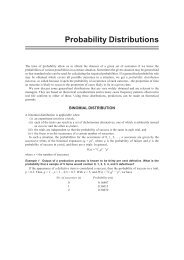International-Business-Dr-R-Chandran-E-book
International-Business-Dr-R-Chandran-E-book
International-Business-Dr-R-Chandran-E-book
Create successful ePaper yourself
Turn your PDF publications into a flip-book with our unique Google optimized e-Paper software.
Types of non-tariff barriers<br />
195<br />
<strong>International</strong> <strong>Business</strong>- <strong>Dr</strong>. R. <strong>Chandran</strong><br />
1. Quota system: The quota system is an important non-tariff barrier. Under<br />
this system, the quantity of a commodity permitted to be imported from<br />
various countries during a given period is fixed in advance. Such quotas<br />
are usually administered by requiring importers to have licenses to import<br />
a particular commodity. Imports are not allowed over and above a<br />
specific limit. This suggests that tariffs restrict imports indirectly while<br />
quotas restrict imports directly. Developing countries may use quotas in<br />
place of tariffs. The quota system acts as a barrier to international trade as<br />
it restricts the flow of goods in an artificial manner. There are different<br />
types of quota and a country can introduce any type of quota as per the<br />
need of the situation.<br />
The types of quotas are:<br />
Tariff quota: A tariff quota combines the features of the tariff as well as<br />
the quantity. Here, the imports of a commodity up to a specified volume<br />
are allowed duty free or at a special low rate of duty. Imports in excess of<br />
this limit are subject to a higher rate of duty.<br />
Unilateral quota: In a unilateral quota system, a country fixes its own<br />
ceiling on the import of a particular item.<br />
Bilateral quota: In a bilateral quota, the quantity to be imported is<br />
decided in advance, but it is the result of negotiations between the<br />
country importing the goods and the country exporting them.<br />
Mixing quota: Under a mixing quota, the producers are obliged to utilise<br />
a certain percentage of domestic raw material in manufacturing the<br />
finished products.<br />
2. Import Licensing: Import licensing is an alternative to the quota system.<br />
It is useful for restricting the total quantity to be imported. In this system,<br />
imports are allowed under license. Importers have to approach the<br />
licensing authorities for permission to import certain commodities.<br />
Foreign exchange for imports is provided against the license. Such<br />
import licenses are the practice in many countries. This method is used to<br />
control the quantity of imports. Import licensing may be used separately<br />
or along with the quota system.<br />
3. Consular formalities: Some importing countries impose strict rules<br />
regarding the consular documents necessary to import goods. Such<br />
documents include import certificate, certificates of origin and certified<br />
consular invoices. Penalties are imposed for non-compliance of such<br />
documentation formalities. The purpose of consular formalities to restrict<br />
Only for Private Circulation





